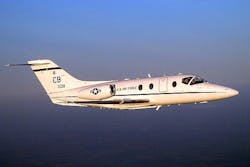Air Force MRO experts pick Field Aerospace to replace avionics suites in T-1A Jayhawk jet trainer
TINKER AIR FORCE BASE, Okla. – U.S. Air Force maintenance, repair, and overhaul (MRO) experts needed a company to replace the avionics suite in the Air Force fleet of 178 T-1A Jayhawk jet trainer aircraft. They found their solution from Field Aerospace in Oklahoma City.
Officials of the air Force Life Cycle Management Center at Tinker Air Force Base, Okla., announced an $18.5 million contract Wednesday to ASES LLC, doing business as Field Aerospace, for the T-1A Avionics Modification Program (AMP).
AMP seeks to replace the avionics in the Air Force fleet of T-1A aircraft, as well as to replace the avionics in 16 operational flight trainer and 14 part task trainer flight simulators.
The T-1A Jayhawk is a commercial derivative of the Beechcraft 400A medium-range, twin-engine jet used to train Air Force student pilots to fly airlift and tanker aircraft. The Jayhawk also provides combat systems officer (CSO) training at Pensacola Naval Air Station (NAS), Fla.
Field Aerospace MRO experts will permanently replace all of the Air Force T-1A aircraft avionics suites and modify T-1A flight simulators to match the new aircraft cockpit avionics. The job includes satisfying the FAA’s Automatic Dependent Surveillance-Broadcast (ADS-B) Out mandate.
Field Aerospace will replace the T-1A's avionics components to include:
-- multifunction display unit;
-- attitude heading computer;
-- fuel totalizer;
-- radio altimeter;
-- radio altimeter indicator;
-- TCAS computer;
-- radio tuning unit;
-- transponder set mode-S;
-- data acquisition unit;
-- data acquisition unit;
-- configuration strapping unit;
-- flux detector;
-- emergency locator transmitter antennas and cable assemblies;
-- audio control amplifier;
-- audio amplifier;
-- display select panel;
-- electronic flight display;
-- display processor unit;
-- maintenance diagnostic computer;
-- GPS receiver;
-- air data computer;
-- weather radar receiver antenna;
-- display control panel;
-- internal compensation unit;
-- mode select panels;
-- MACH speed indicator;
-- altimeter indicator;
-- power supply;
-- flight control computer;
-- adapter radar;
-- lightning and high-intensity radiated field protection;
-- VHF communications transceiver;
-- ADF receiver;
-- air data module;
-- control display unit;
-- VHF navigation receivers;
-- DME transmitter;
-- flight management computer;
-- radio altitude converter;
-- ground collision avoidance computer; and
-- fuel quantity indicator.
Company experts will use industry-standard commercial off-the-shelf (COTS) avionics components and line-replaceable units (LRUs) to facilitate future system growth.
The contract calls for Field Aerospace to provide two complete prototype avionics suite installations and three fully operational prototype simulator modifications that match the modified T-1A aircraft avionics configuration within the next year.
Field Aerospace also will provide spare parts, training materials, aircraft manuals, cyber security, and related support.
On this contract Field Aerospace will do the work in Oklahoma City; Randolph Air Force Base, Texas; Columbus Air Force Base, Miss.; Vance Air Force Base, Okla.; Laughlin Air Force Base, Texas; and Pensacola Naval Air Station, Fla., and should be finished by August 2025.
For more information contact Field Aerospace online at www.fieldaero.com, or the Air Force Life Cycle Management Center at www.wpafb.af.mil/aflcmc.
Ready to make a purchase? Search the Military & Aerospace Electronics Buyer's Guide for companies, new products, press releases, and videos

John Keller | Editor
John Keller is editor-in-chief of Military & Aerospace Electronics magazine, which provides extensive coverage and analysis of enabling electronic and optoelectronic technologies in military, space, and commercial aviation applications. A member of the Military & Aerospace Electronics staff since the magazine's founding in 1989, Mr. Keller took over as chief editor in 1995.

